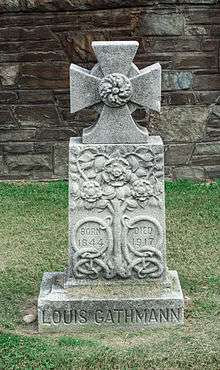Louis Gathmann
Louis Gathmann (August 11, 1843 – June 3, 1917) was a German American engineer and an inventor who is best remembered as the inventor of the Gathmann gun, a large howitzer.
Louis Gathmann | |
|---|---|
 Louis Gathmann | |
| Born | Louis Gathmann August 11, 1843 |
| Died | June 3, 1917 (aged 73) Washington, D.C., U.S. |
| Occupation | Weapons designer |
Life and career

Gathmann was born in Hanover.[1] His father was a school teacher, and instilled in his son a lifelong love of astronomy.[2]
He moved to the United States in 1864,[3] and eventually moved to Chicago where he lived until the end of the 19th century, when he moved to Washington, D.C. He started his career designing equipment for mills and farms,[4] and held numerous patents. By the 1880s, Gathmann's patents were in such demand that he had to form a company to help track and produce his designs. This company, known as the Garden City Mill Furnishing Company, made milling machines which were sold all over the globe.[2]
By the 1880s, Gathmann had made enough money to have his family moved to the United States from Prussia. He also had four mansions built, two in Chicago, one in Washington D.C., and one in Baltimore, Maryland. Gathmann was very interested in astronomy and had three observatories built in the Chicago area during the 1880s, one of which was a domed observatory tower which he had installed on the side of his mansion on Lincoln Avenue.[2][3] In the 1890s, Louis had invented a "Sectional Telescope Lens."[2]
Louis was also involved in 19th century weather modification projects, and in 1891 received a patent for a rain-making in which liquid carbon dioxide was released into the atmosphere by explosion (either from an artillery shell or by being carried aloft by a balloon).[5] He also wrote a book on the subject, Rain Produced At Will.[6]
From the 1890s on, Louis Gathmann focused on ordnance development. The largest gun designed by Gathmann was the 18-inch Gathmann Gun,[1] which was a coastal defense gun manufactured by Bethlehem Steel under Emil Gathmann (head of Bethlehem Steel's Ordnance Section, and one of Gathmann's sons).[7] The gun was tested at Sandy Hook,[8] but the projectile performed far worse than traditional armor-piercing rounds.[9] Louis was also involved with early aircraft development and had attempted to develop a helicopter,[10] but his successes came in developing fuses for high-explosive ordnance.[11] Newspapers reported in the spring of 1915 that Gathmann invented the German 42-cm Big Bertha howitzer, and that these plans were subsequently stolen from the U.S. Patent Office. But these rumors were false, as no such blueprints were ever filed.[12]
During World War I, Louis conceived a multi-hull naval armor design which incorporated buffer zones, shocks and deflectors.[13]
Gathman is also the likely engineer of a submarine that was recovered from the Chicago River in December 1915 and was at that time popularly dubbed "The Foolkiller".[14]
Gathmann died on June 3, 1917, and was buried in Glenwood Cemetery.[15] He was survived by his wife, three sons, and two daughters.[16]
References
- Faust 1909, p. 91.
- "An Amateur Astronomer". Scientific American. April 17, 1886. p. 8582. Retrieved September 1, 2014.
- Louis Gathmann's Private Observatory & March 11, 1881, p. 150.
- "Notes". The Northwestern Miller: 1253. December 18, 1901.
- Advisory Committee on Weather Control 1958, p. iv.
- Gathmann, Louis (1891). Rain Produced At Will. Chicago, Ill.
- Gathmann, Emil (May 18, 1901). "Gathmann's 18-inch Torpedo Gun". Scientific American. pp. 313–314. Retrieved September 1, 2014.
- "Testing the Gathmann 18-Inch Gun". Collier's. November 30, 1901. p. 8. Retrieved September 1, 2014.
- Maxim, Hiram (1916). Dynamite Stories and Some Interesting Facts About Explosives. New York: Stokes and Co. pp. 6–8; "Gathmann Guns Fails to Do Its Work". The New York Times. November 16, 1901; "Death of Louis Gathmann". Scientific American. June 6, 1917. p. 591. Retrieved September 1, 2014.
- Throne, J. Frederick (February 1904). "An Era of Air-Ships". Munsey's Magazine. pp. 650–651. Retrieved September 1, 2014.
- Gathmann, Emil (December 1900). "Torpedo Safety Devices". United States Naval Institute Proceedings: 631–632. Retrieved September 1, 2014.
- "Stolen Gun Plans A Myth". The New York Times. July 7, 1915. p. 22.
- "Protecting a Battleship With a Belt of Air". Popular Science. July 1916. pp. 18–19. Retrieved September 1, 2014.
- "The Foolkiller Pt 5: The White Whale". March 10, 2020. Retrieved April 5, 2020.
- "Big Gun Inventor Dies at His Home In Capital". The Evening Star. June 4, 1917. p. 16.
- "Inventor's Funeral Today". The Washington Post. June 4, 1917. p. 5.
Bibliography
- Advisory Committee on Weather Control (1958). Final Report. Volume 1. Washington, D.C.: U.S. Government Printing Office.CS1 maint: ref=harv (link)
- Faust, Albert Bernhard (1909). The German Element in the United States With Special Reference to Its Political, Noral, Social, and Educational Dnfluence. Boston: Houghton Mifflin Co.CS1 maint: ref=harv (link)
- "Louis Gathmann's Private Observatory". The Northwestern Miller. March 11, 1881.
- "Notes". The Northwestern Miller. December 18, 1901.